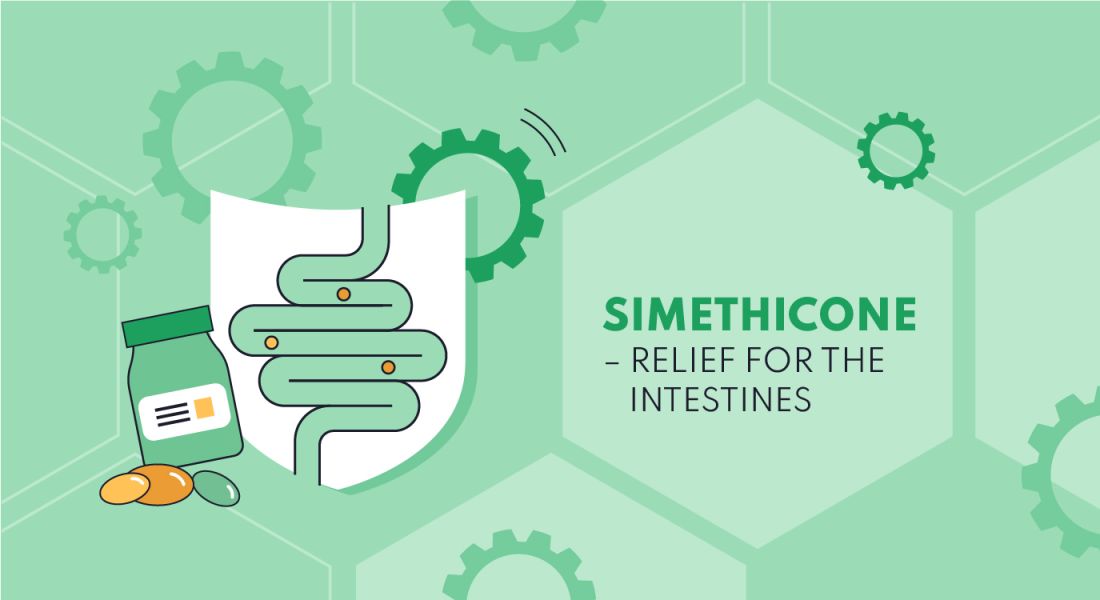

Simethicone: relief for the intestines
Intestinal gas and bloating: what it is and where it comes from
Gases are naturally present in the intestinal lumen. They come from air swallowed during eating or speaking and from intestinal fermentation, occurring mainly in the large intestine. Depending on their origin, gases are also characterised by varying composition. Nitrogen and oxygen are mainly present in the swallowed air. On the other hand, gases originating from bacterial metabolism in the intestine have a more varied composition and include odourless gases such as carbon dioxide, methane and hydrogen, as well as gases which give off a specific odour: hydrogen sulphide and other sulphur derivatives. The amount and type of gases from fermentation depend on the type of food consumed, the composition of the intestinal flora and the efficiency of intestinal transit. Under physiological conditions, the volume of gas in the intestine is usually 200 ml and the total daily volume of wind excreted is up to 600 ml. A healthy person excretes gases (commonly called “wind”) from a dozen to 24 times a day [mp.pl gases]. Excessive accumulation of gases in the digestive tract results in abdominal discomfort, a feeling of fullness, tightness, and sometimes even pain, i.e. the occurrence of flatulence. It is estimated that up to 30% of adults suffer from occasional flatulence, with women twice as likely to suffer from it as men. This symptom usually increases after meals, especially those differing in composition and volume from the daily diet, e.g. during banquets, parties or family celebrations. Increased intestinal gas may be caused by:- consumption of foods considered to be gas-forming (beans, cabbage, potatoes, prunes, milk);
- increased swallowing of air, e.g. during smoking, chewing gum and drinking carbonated beverages;
- impaired digestion and absorption in the small intestine and slower intestinal transit resulting in increased amounts of fermentable substrates in the large intestine.
- psychological factors, e.g. refraining from belching or passing gas in public places.
Simethicone
It is a substance commonly used to relieve flatulence. It reduces discomfort caused by the presence of excess gas in the digestive tract. It was first approved by the FDA in 1952 as a medicinal product. Currently, due to its physical and local mechanism of action in the pharmaceutical market, we are seeing more and more registrations of products with simethicone in the category of medical devices.Mechanism of action
Simethicone is a silicone compound that acts as a topical surfactant to reduce the surface tension of gas bubbles in the intestines. This action causes gas bubbles to burst, facilitating their removal. The substance is not absorbed from the gastrointestinal tract and therefore has no systemic effect. It is excreted from the body with the faeces. Simethicone is not only highly effective, but also very safe.Application:
Simethicone is administered orally. In case of flatulence, in children over 12 years of age and adults, up to 240 mg of simethicone may be given at one time up to 4 times a day (total max 960 mg). In order to prepare for diagnostic examinations in the abdominal cavity, 240 mg of simethicone is administered on the day before the examination and the same amount on the day of the examination. The intake of the substance should be combined with the consumption of plenty of water (about 1 glass) to ensure optimal effects.Author
R&D Department, Curtis Health Capstel.: +48 61 625 27 00
fax: +48 61 625 27 01
office@chc.com.pl
bd@chc.com.pl
purchasing@chc.com.pl
rd@chc.com.pl
BDO: 000102401
Wysogotowo
ul. Batorowska 52
62-081 Przeźmierowo
POLAND
District Court for Poznań - Nowe Miasto and Wilda in Poznań, the 8th Commercial Division of the National Court
KRS 0000871229
NIP 781-00-41-371
Share capital: 36 100 000PLN
© Curtis Health Caps. All rights reserved.


